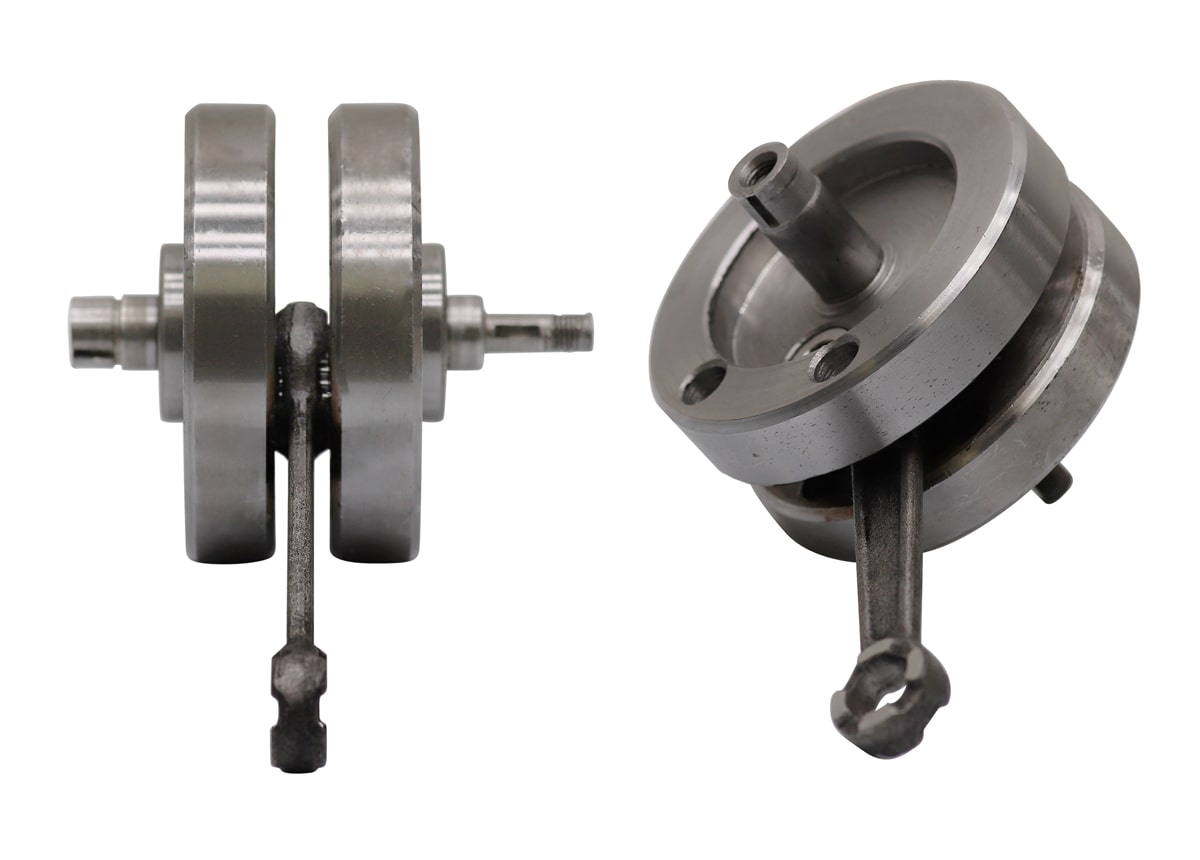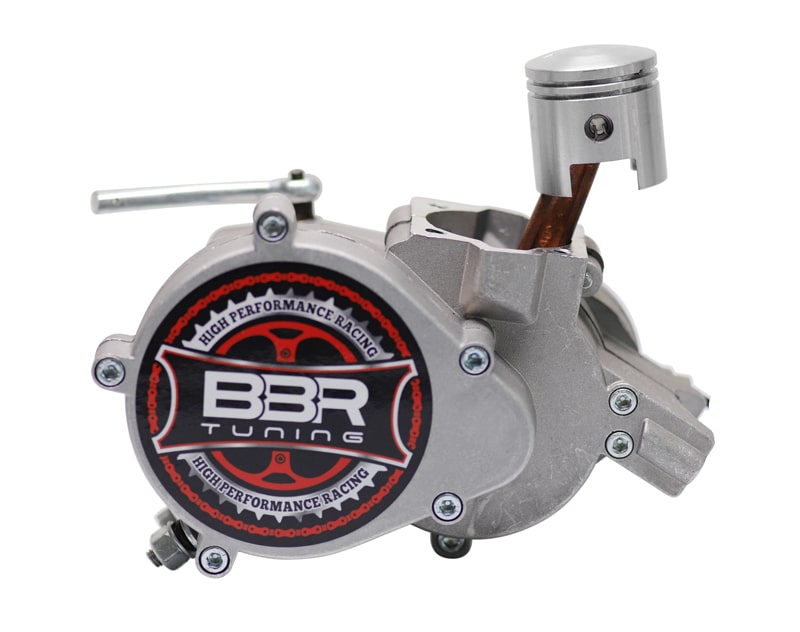 If you have a 2-stroke engine, one seemingly small feature that has a major impact on your bike’s engine displacement, fuel efficiency, and power input is the crank stroke. As you will see in this guide, even a tiny variance in the crank stroke length can completely change the engine’s performance.
Crank stroke plays a major role when it comes to the performance of a 2-stroke engine. There are two main types of crank strokes that are typically used in 2-stroke engines: 40mm crank strokes and 38mm crank strokes. This guide will detail the key differences between 40mm and 38mm crank strokes found on 2-stroke engines.
If you have a 2-stroke engine, one seemingly small feature that has a major impact on your bike’s engine displacement, fuel efficiency, and power input is the crank stroke. As you will see in this guide, even a tiny variance in the crank stroke length can completely change the engine’s performance.
Crank stroke plays a major role when it comes to the performance of a 2-stroke engine. There are two main types of crank strokes that are typically used in 2-stroke engines: 40mm crank strokes and 38mm crank strokes. This guide will detail the key differences between 40mm and 38mm crank strokes found on 2-stroke engines.
Pistons and Connecting Rods
A major difference between 38mm crank strokes and 40mm crank strokes is the pistons and connecting rods they use. It is vital that you know which types of pistons and connecting rods you can use with your 2-stroke engine in order for it to operate smoothly. Here is the most important information you need to know when considering a 40mm versus 38mm crank 2-stroke engine piston and connecting rod: There are two main types of 66cc/80cc pistons that are used in 2-stroke engines: type A (low hole pistons like the 66/80cc 2-Stroke Dual Window Piston #3) and type B (high hole pistons like the 66/80cc 2-Stroke Dual Window Piston #1). With type A pistons, the wrist-pin location is situated near the bottom of the piston. With type B pistons, the wrist-pin is located near the middle of the piston. This is due to the size of the connecting rod that is used with each type of piston.
Type A pistons are typically used with 40mm crank strokes, and Type B pistons usually go with 38mm crank strokes.
Each of these pistons has specific types of connecting rods that they are able to work in conjunction with inside of your 2-stroke engine. If you use the wrong connecting rod, you risk damaging your cylinder head and other parts of your engine, so it is important that you choose an appropriate pairing.
Here are the connecting rods you should use with each piston depending on your engine’s crank stroke:
There are two main types of 66cc/80cc pistons that are used in 2-stroke engines: type A (low hole pistons like the 66/80cc 2-Stroke Dual Window Piston #3) and type B (high hole pistons like the 66/80cc 2-Stroke Dual Window Piston #1). With type A pistons, the wrist-pin location is situated near the bottom of the piston. With type B pistons, the wrist-pin is located near the middle of the piston. This is due to the size of the connecting rod that is used with each type of piston.
Type A pistons are typically used with 40mm crank strokes, and Type B pistons usually go with 38mm crank strokes.
Each of these pistons has specific types of connecting rods that they are able to work in conjunction with inside of your 2-stroke engine. If you use the wrong connecting rod, you risk damaging your cylinder head and other parts of your engine, so it is important that you choose an appropriate pairing.
Here are the connecting rods you should use with each piston depending on your engine’s crank stroke:
Type A Piston
 Type A piston with low skirt and pin hole.
Type A piston with low skirt and pin hole.- Z-L & ZL connecting rods: This is an older type of connecting rod with a non-caged bearing, and it is used for 2-stroke engines with a 40mm crank stroke.
- Unmarked short connecting rods: While these are not labeled specifically, they were used in earlier engines, and their short size gives them the perfect geometry for 40mm crank strokes. While these are mostly seen with 40mm crank strokes, they were previously used with 38mm crank strokes.
- ZAE50 connecting rods: These connecting rods are unique for two reasons. First, they are only used with special crank setups. Furthermore, they are only used for 38mm crank strokes. This is unusual because while it is meant to be used with a 38mm crank stroke, it does not use a type B piston. For that reason, this connecting rod is often referred to as a “half-breed” connecting rod.
Type B Piston
 Type B piston with high skirt and pin hole.
Type B piston with high skirt and pin hole.- FM80 connecting rods: These connecting rods work with type B pistons to form a 38mm 2-stroke engine.
- ZAF80 connecting rods: This type of connecting rod is rarer, but it is the proper length and shape to work with a type B piston and a 38mm crank stroke.
Performance
Knowing your piston size and type, you'll need to consider the impact that 40mm crank strokes and 38mm crank strokes will have on your bike’s performance. There are advantages and disadvantages to both types of strokes, so you will need to determine which option is best for you.Advantages of a 40mm Crank Stroke
A 40mm crank stroke has its share of advantages that make it a favorite among 2-stroke engine users. 2-stroke engine with 40mm crank.
2-stroke engine with 40mm crank.- Increased engine displacement: The size of a crank stroke directly contributes to the total swept volume of an engine’s cylinders. In fact, the formula for determining an engine’s displacement is 0.7854 x bore x bore x stroke x number of cylinders. This means engine displacement is greater when an engine has longer crank strokes. For help determining your engine’s displacement, here is an engine displacement calculator.
- Increased torque: Larger engines with greater displacement are able to move more air through the engine’s cylinders. This increase in force causes more torque.
- Increased power: The greater your crank stroke length, the more air you can push through your 2-stroke engine, thus resulting in more power.
Advantages of a 38mm Crank Stroke
 2-stroke engine with 38mm crank.
2-stroke engine with 38mm crank.- Fuel efficiency: Smaller engines tend to require less fuel to operate, so motorized bikes with shorter crank strokes are more fuel-efficient and they typically cost a lot less when it comes to upkeep and maintenance. Engines with 38mm crank strokes usually last longer as a result, as well.
- Higher revolutions per minute (RPM): Engines with shorter crank strokes are able to perform at a higher RPM because the decreased air-fuel mixture allows for quicker combustion.
- Acceleration: With a smaller 2-stroke engine, it takes less time for the engine to complete a full compression and downward stroke cycle, which means it takes less time for the motorized bike to rev up to its max RPM.
Crank Stroke Length
Overall, a 2-stroke engine requires only two piston movements in order to operate: an upward compression stroke and a downward power stroke. The distance that pistons travel in order to generate power is known as the stroke length, which can be found by looking at the crank angles of the engine’s crankshaft. It is important to know how 40mm crank strokes and 38mm crank strokes differ so you can decide which option will be best for your particular bike and your riding needs.Physical Differences
There are a number of physical differences between 2-stroke engines that use 40mm crank strokes and 2-stroke engines that use 38mm crank strokes. This is largely due to the differences in length of each crank stroke. As its name would suggest, the 40mm crank stroke is longer than the 38mm crank stroke. Because the 40mm crank stroke is longer, it requires a shorter connecting rod (typically around 85mm) than a 38mm crank stroke would use (typically around 89mm).
Engines with a 40mm Crank Stroke
Typically, engines with a 40mm crank stroke have the following physical properties:- Short (85mm) connecting rods.
- Pistons with low wrist-pin locations.
- High engine displacement (higher CC engines).
Engines with a 38mm Crank Stroke
Engines with a 38mm crank stroke usually have the following physical properties:- Longer (89mm) connecting rods.
- Pistons with high wrist-pin locations.
- Lower engine displacement (lower CC engines).
Deciding Between a 40mm and 38mm Crank Stroke
 40mm crank.
40mm crank.Measuring Your Crank Stroke
 38mm crank.
38mm crank.- Use a dial caliper and a piston deck bridge.
- Place the dial caliper on the piston deck bridge (or a dial indicator stand) with the jaws facing up.
- Making sure your piston is at the top dead center position (farthest from the crankshaft), put the deck bridge over the cylinder.
- Tare or zero out the dial caliper.
- Turn the crankshaft until the piston moves to the bottom dead center position (closest to the crankshaft).
- The dial caliper reading will let you know your motorized bike engine’s crank stroke.
Understanding 40mm and 38mm Crank Strokes
 Whether you already have a motorized bike with a 2-stroke engine, or you are in the market for one, it is crucial that you are aware of the differences between 40mm crank strokes and 38mm crank strokes. This will determine the exhaust ports the engine uses, as well as the types of pistons and connecting rods that are compatible with the engine. It will also determine the overall performance of the 2-stroke engine.
Using this guide, you will be able to determine not only which engine model and crank stroke length is right for you and your bike, but also which engine kit parts you will be able to use for your motorized bike’s 2-stroke engine.
Whether you already have a motorized bike with a 2-stroke engine, or you are in the market for one, it is crucial that you are aware of the differences between 40mm crank strokes and 38mm crank strokes. This will determine the exhaust ports the engine uses, as well as the types of pistons and connecting rods that are compatible with the engine. It will also determine the overall performance of the 2-stroke engine.
Using this guide, you will be able to determine not only which engine model and crank stroke length is right for you and your bike, but also which engine kit parts you will be able to use for your motorized bike’s 2-stroke engine.





2 comments
Mike
Take a black solid rubber Bungee cord and cur the 3/16" rubber and place it as a motor mount in the 4 stroke engine not 2 stroke, works great!
Angel Colon
Great article ! Always something new to learn. Thanks .